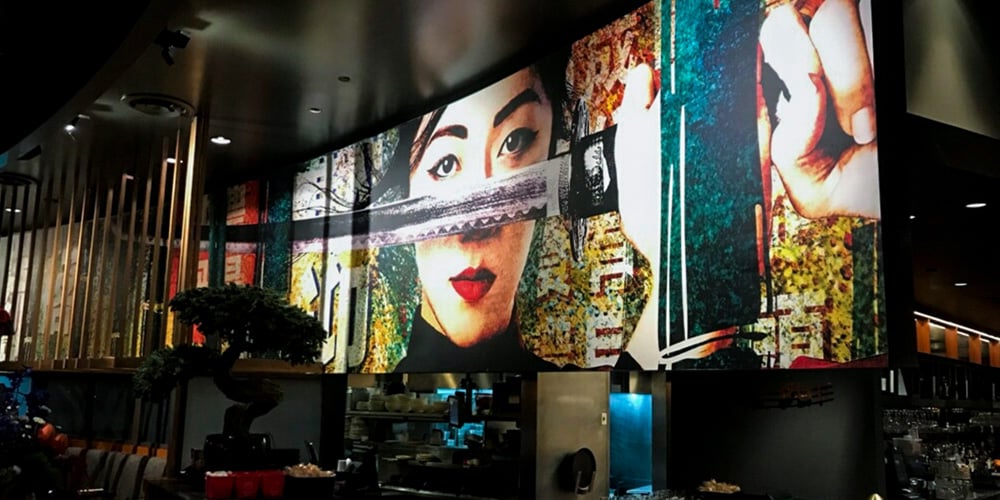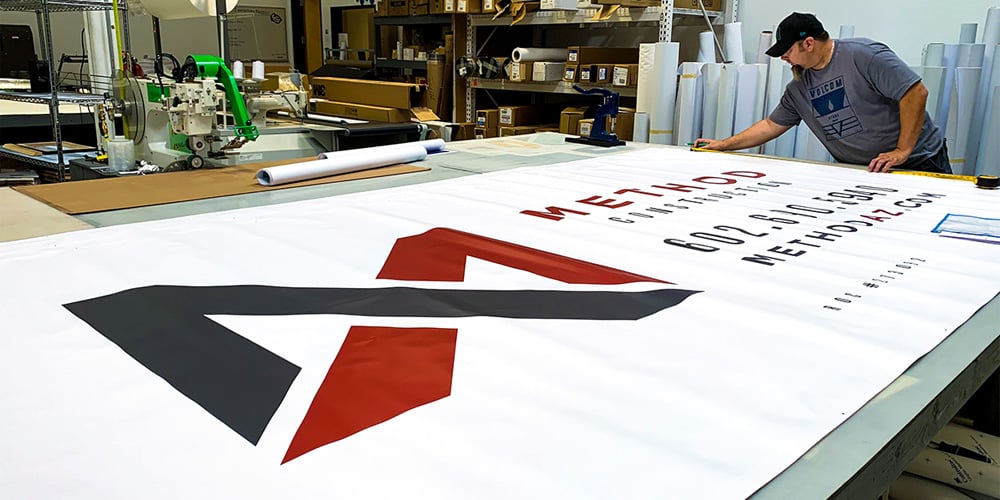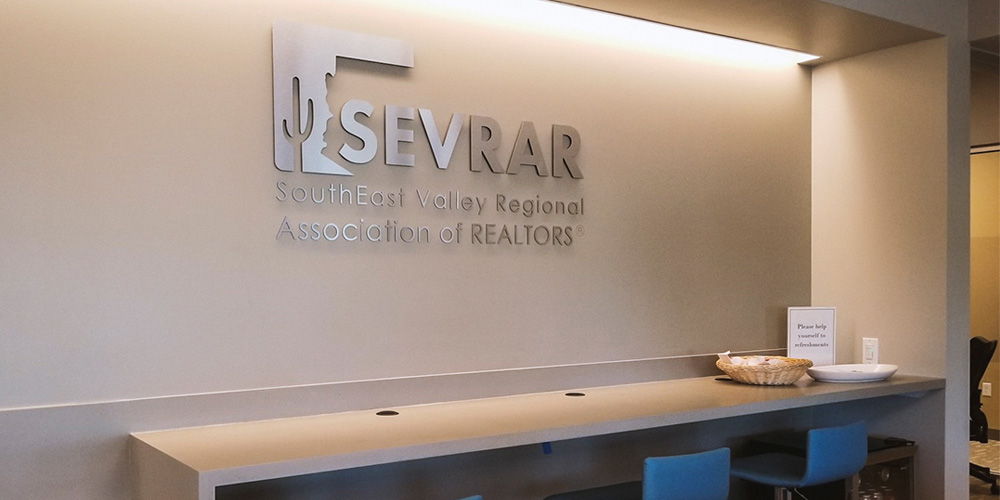Outdoor Signage: 12 Tips for the Best Color, Design, and Font

I saw the sign,
And it opened up my eyes,
I saw the sign…
Like a pop hit from the ’90s, outdoor signage needs to connect and linger in the minds of target audiences instantly.
Signage that doesn't immediately convey its intended message risks being ignored or misunderstood. In fact, 54% of people failed to find a business because the outdoor signage was neither memorable nor visible.
Ensure your outdoor signage is clear, compelling, and unforgettable with our top tips for standout signs, including:
- What is the best color for outdoor signage?
- How to design an effective outdoor sign.
- Which font is best for readability?
What is the Best Color for Outdoor Signage?
The best color for outdoor signage varies based on location, the surrounding environment, brand guidelines, and the sign's intended purpose.
While no single color is universally considered the best, one best practice should be followed for all outdoor signs: contrasting colors.
Contrasting colors are two colors at opposite ends of the color wheel. 
For example, black and white are the most common contrasting colors. As polar opposites on the color wheel, the white text appears bold and clear against a black background. Other contrasting color pairs include:
- Yellow and purple.
- Red and green.
- Orange and blue.
Contrasting colors are critical for visibility and readability, and signs using disparate colors are remembered nearly 40% more than those without.
Here are three 3 tips for selecting colors that ensure stand-out signage.
1. Find Contrasting Colors on the Color Wheel
To achieve the highest level of contrast, pick two colors directly across from each other on the color wheel. Ideally, try to choose two colors that differ not only in hue but also in value (lightness or darkness) and saturation (the intensity of the color).
2. Consider Adding a Border
For added contrast, consider adding a border color around the sign's perimeter. This technique is commonly used on interstate highways to ensure signs are visible to drivers passing by at high speeds.  3. Factor in the Sign’s Surroundings
3. Factor in the Sign’s Surroundings
Think about a stop sign. Why is it red? Its bold, bright red color is designed to catch your attention and stand out from the surrounding buildings, blue skies, and green trees.
When selecting colors for your sign, consider its location–including what’s behind and around the sign–to ensure it doesn’t blend into its surroundings.
How to Design an Effective Outdoor Sign
Remember the ole’ five-second rule about eating food that fell on the ground? Apply a similar rule when designing an outdoor sign.
Unlike print marketing or digital advertising–where target audiences can easily scroll back or grab a brochure for more information–outdoor signs must clearly communicate a memorable message in less than five seconds.
For this reason, it’s crucial that outdoor signs are designed with simplicity in mind.
Here’s how to ensure your business signage and graphics deliver a clear, compelling, and unforgettable message in less than five seconds.  4. Keep the Word Count as Low as Possible
4. Keep the Word Count as Low as Possible
The speed at which a sign can be read and understood directly influences its effectiveness. To ensure your sign gets the message across quickly and clearly, the main message of an outdoor sign should contain seven words or less.
5. Add Context Without Adding Word Count
If your sign’s word count is too high or if it takes longer than five seconds to understand, consider using easy-to-recognize graphics or images to add context to the sign’s message.
For example, in ancient Rome, shop owners used well-known emblems to depict their offerings since most of the population was illiterate. Ever heard the saying, “A good wine needs no bush?” The origin of this proverb lies in Roman tavern signage, where the image of a bush was used to indicate the availability of wine.
6. Use Rhymes, Repetition, or Alliteration
Another way to add context without increasing word count is to use mnemonic devices, such as rhymes, repetition, or alliteration. For instance, “Real Food, Real Fast” engages the brain's auditory and language processing areas to make the information more memorable.
7. Incorporate White or Negative Space
When designing your sign, it is essential to allocate 30-40% of the area for white or negative space. This helps reduce visual clutter, enhance the visibility of the text, and make the overall design easier to read.
8. Avoid Using Too Many CTAs
Offer a single call to action (CTA), such as a website URL, phone number, QR code, special offer, or location, to make it easy for target audiences to act on your sign's message.
Which Font is Best for Readability?
More than 200,000 fonts exist; however, very few are appropriate for outdoor signage.
For example, Times New Roman is used in most newspapers, magazines, and print marketing collateral since serif fonts are easier to read in print, but caution is advised when using serif fonts in outdoor signage. The decorative lines in serif fonts can blend together when viewed from a distance, potentially hindering readability.
The most effective fonts for outdoor signage, such as Helvetica, Futura, and Bodini, are clear and easily read from a distance.
Using these popular fonts is a great choice for ensuring visibility and clarity. However, if your sign is in a competitive environment where other signs use similar fonts, or if these fonts don't align with your brand guidelines, you may want to consider other fonts.
Regardless of what font you choose, these four tips will ensure the long-distance readability of your sign.
9. Avoid Fonts that are Too Thick or Too Thin
If a font is too heavy or thick, the words can blur together when viewed from a distance. On the other hand, fonts that are too thin can become virtually invisible from a distance, particularly in bright sunlight or exterior lighting.
10. Use Kerning to Adjust the Spacing of Letters
Kerning is the process of increasing or decreasing the space between each letter. By adjusting the s p a c i n g between characters, kerning ensures that each letter is distinctly separate from its neighbors. This technique is an easy way to make thick or intricate fonts easier to read from a distance.
11. Limit the Number of Fonts
Too many fonts can make a sign look cluttered and hard to read, so it's best to use no more than two complementary fonts. When using two fonts, select ones that are different enough to create visual interest but similar enough to maintain a cohesive look.
12. Determine the Right Font Size
The legibility index considers factors like font size, type, spacing, contrast, and text layout to calculate the relationship between letter height and viewing distance to determine the best font size for a readable sign. Due to its complexity, professional printing companies typically only use the legibility index. However, there’s a general rule for determining the right font size for your sign: for a font to be legible from a distance, it’s advised to use lettering that's one inch tall for every 10 feet of viewing distance.
For example, if a sign needs to be readable from 150 feet away, the font should be 15 inches tall.
Remember that this is only a rough estimate. To ensure the correct font size, you may want to consider working with a printing company experienced in outdoor signage.
Clear, Compelling, and Unforgettable Outdoor Signage by Artisan Colour
Now that you know the essentials of effective outdoor signage, let’s bring your vision to life.
Since 1998, Artisan Colour has helped businesses in our hometown of Scottsdale and nationwide create high-impact signs that command attention.
From design to printing to installation, our in-house team of experts and state-of-the-art printing equipment can handle all your signage and graphic needs, including:
- Indoor and outdoor signage.
- Wall, window, and building graphics.
- Trade show and event signage.
- Retail signage and displays.
- Vehicle wraps.
- Building wraps.
- Corporate signage.
- Directory signs and ADA-compliant signage.
Contact Artisan Colour today to discuss what you have in mind for your next signage project. We can’t wait to bring it to life.






